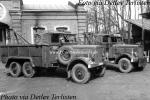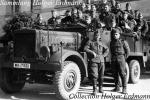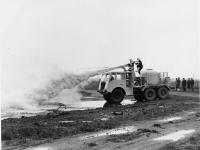MAN » Einheits-Diesel
The development of the Einheits-Lastkraftwagen – which means standard-lorry – started in 1934. It was planned to develop vehicles with 2, 3 and 4 axles with payloads of 1.5, 2.5 and 4 tons. In the end, only the model with three axles and 2.5 tons payload entered serial production. Leading by developing the chassis was Henschel. The diesel engine with a power of 80 HP was developed by MAN in cooperation with Henschel and the Humboldt-Deutzmotoren AG. The power was transmitted to all three axles via a commercial four gear transmission and a two-stage transmission with lockable differential. So, eight gear transmission ratios were available. Each axle had an additional self-locking transmission. All six propelled wheels had independent suspension and single tyre arrangement. All this lead to the outstanding cross-country mobility of the Einheits-Diesel. Nine manufactures were joint to producing: Büssing-NAG, Daimler-Benz, Faun, Vomag, Henschel, Krupp, Magirus, MAN and Borgward. Contrary to the Einheits-Pkw’s, the Einheits-Diesel was made absolutely identical by all nine manufacturers. Totally 17500 Einheits-Diesel were produced since 1937 to 1940, included 1795 trucks produced by MAN.





